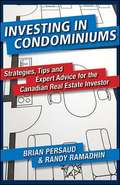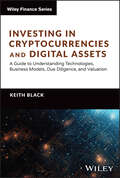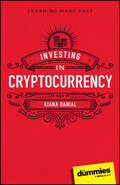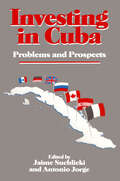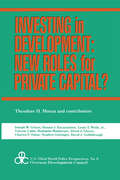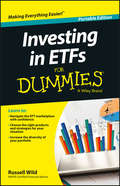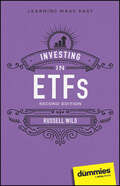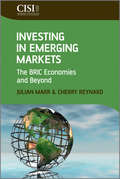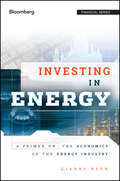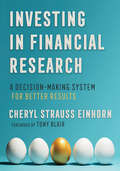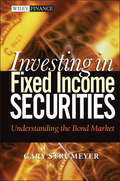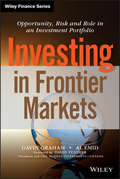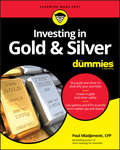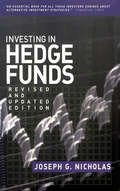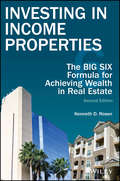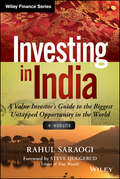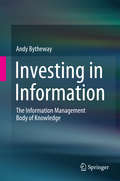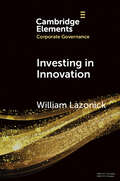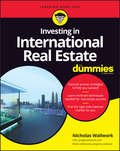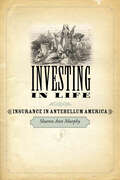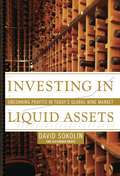- Table View
- List View
Investing in Condominiums
by Brian Persaud Randy RamadhinA lot of information has been published for those who wish to buy a condo as a principal residence, but not for investors who want to expand into the condominium market. Investing in condominiums is not about being caught up in the mass hysteria of lining up to buy a pre-construction unit in a "hot neighbourhood" and hopefully flipping it at a profit when it's built. On the contrary, investing in condos can be a very good way to generate solid returns when done according to the proven strategies outlined in the book. Investing in Condominiums will show readers the ins and outs of profitable condo investing by sticking to investing fundamentals, carrying out proper due diligence, and having an exit plan. Pre-construction condominiums, especially in Toronto and Vancouver are sought-after by both Canadian and international investors. The stable economy, low-interest rate environment, and appreciating values are a recipe for investor success. Investing in Condominiums gives Canadian investors the nuts and bolts of undertaking such an investment based on real-life examples and expert knowledge. By reading this book, the investor can proceed with full confidence knowing that they are asking the right questions, doing the math, and assembling the right team of experts that will help them realize their investment goals.
Investing in Cryptocurrencies and Digital Assets: A Guide to Understanding Technologies, Business Models, Due Diligence, and Valuation (Wiley Finance)
by Keith H. BlackA must-read roadmap to analyzing, valuing, and investing in cryptocurrency and other digital assets In Investing in Cryptocurrencies and Digital Assets: A Guide to Understanding Technologies, Business Models, Due Diligence, and Valuation, alternative investments expert Dr. Keith Black delivers a compelling and straightforward roadmap for analyzing, valuing, and investing in crypto and other digital assets. You'll learn how to buy crypto directly — and how to keep your new digital assets safe from hacks and fraud — and how to invest indirectly, using stocks, futures, options, and exchange-traded funds. You'll also discover how to conduct extensive due diligence to reduce technology and compliance risks, as well as how to understand the business models that underlie and power these novel technologies. The book also offers: Accessible discussions of and introductions to blockchain and distributed ledger technology, stablecoins, Bitcoin, Ethereum, and other foundational concepts Ways to differentiate between investing in digital assets for the long term and risky, short-term speculation An essential new playbook for institutional, professional, and retail investors involved with digital assets and cryptocurrency, Investing in Cryptocurrencies and Digital Assets is the comprehensive and up-to-date guide to the sector that you've been waiting for.
Investing in Cryptocurrency For Dummies
by Kiana DanialUnlock the mysteries of cryptocurrency investing Investing In Cryptocurrency For Dummies gives you detailed information and the expert advice you need to successfully add cryptocurrency to your investment portfolio. If you’re interested in making money in the unregulated cryptocurrency markets, this is the guide for you. You’ll learn how to buy and sell digital currencies, profiting from price fluctuations regardless of the market environment. You’ll also gain the knowledge you need to make smart long-term investments in crypto. Real-world examples show you how to maximize your profit potential and avoid common pitfalls. Figure out what cryptocurrency is and learn the ins and outs of the crypto market Learn how to buy and sell digital currencies Understand cryptocurrency wallets and why you need one Make smart trades for the long and medium term Incorporate cryptocurrency into a broader strategy for a diversified portfolioInvesting In Cryptocurrency For Dummies is a great resource, whether you’re a curious newbie who has countless crypto questions or an experienced investor who wants to expand their crypto strategy.
Investing in Cuba: Problems and Prospects
by Antonio Jorge Jaime SuchlickiFirst published in 1994. This is a collection of essays from the seminar hosted by the Canadian Institute of Strategic Studies (CISS) on "Investing in Cuba: Problems and Prospects," with The Research Institute for Cuba (RIC). These papers identifying problems and risks associated with foreign investment in Cuba. Appendices reproduce the foreign investment law of 1982 (since replaced by a new foreign investment law passed in 1995) and accompanying regulations. The collection of edited papers in this volume were originally presented at the seminar, and their authors were chosen to represent a wide range of views.
Investing in Development: New Roles for Private Capital?
by Theodore MoranThis volume surveys current views in the debate about the impact of foreign direct investment on Third World development--on growth, employment, exports, technology, and distribution of income. It examines whether the efforts of less developed countries to attract and control multinational corporations have constituted a serious "distortion" of trade that threatens jobs in the home nations. It provides new studies of foreign investment in agriculture and in the least developed states. It looks at the threat of transmitting environmental pollution. And it analyzes the link between international companies and the "umbrella" of World Bank cofinancing as a mechanism to reduce risk. Finally, it attempts to estimate how much of the "gap" in commercial bank lending might plausibly be filled by direct corporate investment over the next decade.
Investing in ETFs For Dummies
by Russell Wild<p>Whether you are a seasoned investor or you're just getting into the investment game, one thing is certain: you need to diversify! <i>Investing In ETFs For Dummies</i> is a practical, easy-to-use resource that introduces you to the world of exchange-traded funds—and provides you with the knowledge you need to incorporate ETFs into your investment strategy. Discover commodity ETFs, style ETFs, country ETFs, and inverse ETFs, all of which play an important role in this new trading environment. Supplement your knowledge with an understanding of the risks and rewards associated with ETF investments, and consider how ETF investments can complement your current portfolio. <p>Though not as well-known as some other investment options, ETFs are wonderful tools for filling in the gaps in your investment portfolio. These investment options have the power to give you access to markets or investment areas that, otherwise, may be restricted, too expensive, or exceedingly risky—and can open investment doors you may have not yet considered. <p> <li>Understand how to navigate the ETF marketplace with confidence <li>Make informed investment decisions based upon fundamental knowledge about the ETF market <li>Explore the latest ETF products, providers, and strategies to guide you in choosing the right ones for your needs <li>Increase the diversity of your investment portfolio, and bring a new facet of potential to your investment strategy</li> <p> <p><i>Investing in ETFs For Dummies</i> is a great resource if you're looking to enhance your investment portfolio by participating in the ETF market!</p>
Investing in ETFs For Dummies
by Russell WildDevelop ETF expertise with this straightforward guide Investing in ETFs For Dummies has all the basics you need to make calculated and profitable choices when investing in exchange-traded funds. ETFs make it possible for investors to quickly and easily gain exposure to wide swaths of the market. There are funds that are linked to popular market indices like the S&P 500, there are quirky thematic funds that allow you to invest in stuff like video game technology or breakfast commodities, and there’s everything in between. This updated guide helps you sift through it all, covering the pros and cons of ETF investing and walking you through new and time-tested ETF strategies. Add some ETFs to your portfolio and profit in any market environment, thanks to this simple Dummies guide. Figure out what ETFs are and learn the ins and outs of the ETF marketplace Learn to research ETFs and weigh the risks so you can make informed trades Discover the latest ETF products, providers, and strategies Gain the confidence you need to invest in ETFs, even in a down marketInvesting in ETFs For Dummies is a great starting point for anyone looking to enhance their investment portfolio by participating in the nearly $2 trillion ETF market.
Investing in Emerging Markets
by Julian Marr Cherry ReynardFor more than a decade, emerging markets have proved one of the most exciting areas of investment, but the sector has not been without its dangers. Private and professional investors alike have continuously been attracted by the promise of riches on offer from countries such as China, India, Brazil and Russia but, as often as not, have been left with their fingers burnt.Investing in Emerging Markets: The BRIC Economies and Beyond tempers the undoubted causes for emerging market optimism with a healthy dose of reality, illustrating how for every argument in favour of investing in the sector there are one or more reasons to tread very carefully indeed.In the wake of the credit crunch and ensuing market turmoil, it also analyses where the emerging markets now fit within the global investment landscape. With the economies of the US, Europe and Japan hit by an economic crisis very much of their own making, has the credibility gap between developed and developing markets narrowed? Has the playing field become more level?Investing in Emerging Markets: The BRIC Economies and Beyond offers a fresh, clear-eyed and objective look at an area that can only grow in importance over the next decade. It balances a realistic appraisal of the opportunities on offer from the emerging markets with a pragmatic assessment of the potential pitfalls facing investors, in the process providing an accessible introduction to newcomers and more experienced investors with a valuable and compact point of reference.
Investing in Energy: A Primer on the Economics of the Energy Industry (Bloomberg Financial #154)
by Gianna BernAn energy industry researcher and investment advisor provides a fresh perspective on the economics of energy From major players in the energy industry, such as big oil, to the emerging cap-and-trade market, no other book offers a more complete overview of the energy industry, specifically its economic and financial intricacies, than Investing in Energy: A Primer on the Economics of the Energy Industry. Details how to value and invest in the four big energy sectors: oil, gas, power, and green Describes key financial considerations for the energy sectors, including credit metrics, the importance of liquidity, cash flow, and capital expenditures From Bloomberg, a leading provider of the most up-to-date business news and financial data A comprehensive guide to the economics of the energy industry, Investing in Energy will prove an invaluable resource for traditional energy investors looking to expand into new areas, as well as for eco-investors looking to better understand how energy markets function.
Investing in Financial Research: A Decision-Making System for Better Results (AREA Method Publications)
by Cheryl Strauss EinhornFinalist in the Business/Personal Finance category of the 2019 International Book AwardsEvery day, people around the world make financial decisions. They choose to invest in a stock, sell their holdings in a mutual fund or buy a condominium. These decisions are complex and financially tricky—even for financial professionals. But the literature available on financial research is dated and narrowly focused without any real practical application. Until now there's been a gap in the literature: a book that shows you how to conduct a step by step comprehensive financial investigation that ends in a decision.This book gives you that how.Investing in Financial Research is a guidebook for conducting financial investigations and lays out Cheryl Strauss Einhorn's AREA Method—a research and decision-making system that uniquely controls for bias, focuses on the incentives of others and expands knowledge while improving judgement—and applies it to investigating financial situations. AREA is applicable to all sorts of financial sleuthing, whether for investment analysis or investigative journalism. It allows you to be the expert in your own life.The AREA Method provides you with: *Defined tasks that guide and focus your research on your vision of success; *A structure that isolates your sources, giving you insight into their perspectives, biases and incentives; *Investigative resources, tips and techniques to upgrade your research and analysis beyond document-based sources; *Exercises to foster creativity and originality in your thinking; *A sequence and framework that brings your disparate pieces of research together to build your confidence and conviction about your financial decision.
Investing in Fixed Income Securities
by Gary StrumeyerInvestors who've primarily purchased equity securities in the past have been looking for more secure investment alternatives; namely, fixed income securities. This book demystifies the sometimes daunting fixed income market, through a user-friendly, sophisticated, yet not overly mathematical format. Investing in Fixed Income Securities covers a wide range of topics, including the different types of fixed income securities, their characteristics, the strategies necessary to manage a diversified portfolio, bond pricing concepts, and more, so you can make the most informed investment decisions possible.
Investing in Frontier Markets
by Gavin Graham Al Emid David FeatherThe only comprehensive guide to reaping big returns investing in the hottest new growth marketsThis book makes a compelling case that, just as today's well-rounded portfolio includes emerging market funds, tomorrow's well-rounded portfolio will include frontier market funds. More importantly, it alerts you to the vast opportunities and potential pitfalls of investing in frontier markets while providing expert advice and guidance on how to research and invest in the most promising frontier growth markets. Widely considered to be the next emerging markets, frontier markets, such as those of certain sub-Saharan African, Eastern European, Asian, and Central and South American countries, are showing strong signs of reaching economic critical mass. If you are an investor on the lookout for authoritative, actionable information on the next big investment opportunity, this book is for you.Provides sector-by-sector analyses that let you assess opportunities and risks in each frontier marketProvides strategies and tools for determining the most efficient methods for executing, monitoring, and exiting investmentsGuides you through the wide diversity within frontier markets, showing how to differentiate countries on the basis of economic development and wealth distribution and other factors
Investing in Gold & Silver For Dummies
by Paul MladjenovicDiversify your portfolio with gold and silver Investing and trading in gold and silver is always a sound idea—and that goes double in a time of unusual market fluctuation. As people look for safe places to diversify their investment risk, you’ll likely see the value of your investment go up where other stocks are vulnerable. Gold and silver saw increases in value of 16% and 15% respectively in 2019—putting them among the top ten most desirable commodities out there—and are projected to experience even more of a bear market as the dollar wobbles in an uncertain post-COVID world. This year, 2020, gold and silver are set up to have their best year of price appreciation over the past 40+ years. Written in an easy-to-follow, no-jargon style by CFP and bestselling author, Paul Mladjenovic, Investing in Gold & Silver For Dummies explains the different complex processes and vehicles for buying gold and silver. You’ll find out the best ways to add these to your portfolio, how to balance risk and reward, and how to adapt time-tested investing plans and strategies to your goals. Identify your goals and form a plan Buy gold and silver safely to diversify your portfolio Use ETFs and options to profit from market ups and downs Understand when a gold and silver investment is legitimate Use technical analysis to time your market entries Whatever your current familiarity with gold and silver, this book gives you the extra expert knowledge you need navigate your gold and silver investment portfolio safely through a bear or bull market.
Investing in Hedge Funds: Strategies For The New Marketplace (Bloomberg Financial #51)
by Joseph G. NicholasHedge funds are in the news and on the minds of sophisticated investors more than ever. Investors have questions about how the funds are structured, where the assets are allocated, and whether hedge funds can truly act as a hedge against market risk. The answers are all here in Investing in Hedge Funds. Until recently, much of what makes hedge funds tick has been closely guarded--the intellectual property of Wall Street's investment elite. In this updated and revised text, Joseph G. Nicholas, founder and chairman of the leading industry information provider Hedge Fund Research, Inc., travels inside the hedge fund marketplace to explain the alternative investment strategies of top fund managers, providing clear descriptions of how to access these funds and where they're headed. It's a complete guide that everyone investing in hedge funds should study closely.
Investing in Human Capital
by Miguel Palacios LlerasThis study recommends employing "human capital contracts" wherein students agree to pay a percentage of their income over time in exchange for funds to finance their education. The main difference between "human capital contracts" and loans is the variable value of the payments students make during the repayment period. Their financial consequences, of risk transfer from students to investors and increased information regarding future graduates' earnings, make the contracts an attractive alternative in funding higher education.
Investing in Income Properties
by Kenneth D. RosenPraise for INVESTING IN INCOME PROPERTIES"Investing in Income Properties is a cogent and well organized presentation of the principles of real estate analysis, financing, and investment. With his 'Big Six Formula,' Ken Rosen shares his knowledge and experiences on how to analyze and take advantage of commercial real estate investment opportunities. This book should be required reading in all real estate investment courses."--John S. Zdanowicz, PhD, Professor, Finance and Real Estate, and Director of the Jerome Bain Real Estate Institute, Florida International University"Ken Rosen has a unique ability to make the most complicated seem clear and easy to follow. In Investing in Income Properties, he gives practical steps so that the reader can take action and begin or continue to build wealth by investing in income properties. This book will become the buyer's bible."--Alex Zylberglait, Associate Director, National Office and Industrial Properties Group, Marcus & Millichap Real Estate Investment Services"Investing in Income Properties is a step-by-step approach to investing in commercial real estate. It is clear, easy reading with every base covered. This book is a great tool for both the new and seasoned investor."--Donna Abood, Chief Executive Officer, Colliers Abood Wood-Fay, Commercial Real Estate"Ken Rosen's style is straightforward and his formula for building wealth is well grounded in the fundamentals--nothing fancy or tricky about it! He even puts the would-be investor at ease by addressing the fear factors of real estate investing. Twenty-one years into my career as a real estate investment sales broker, I have met many successful investors, but Ken Rosen clearly stands out as a savvy, self-made entrepreneurial investor who is generously sharing his wealth of knowledge and insight in this very instructive and easy-to-read book."--David L. Meline, Executive Director, Capital Markets Group, Investment Sales Specialist, Cushman & Wakefield of Georgia Inc."One of the best, precise, and accurate real estate books on the market. A must-read for investors at any stage."--Scott K. Sime, Managing Director, CB Richard Ellis Brokerage, Miami-Dade County
Investing in Income Properties: The Big Six Formula for Achieving Wealth in Real Estate
by Kenneth D. RosenKen Rosen argues that successful real estate investors do not get rich in an up market. They get rich and stay rich by investing in real estate for the long-run. And, in fact, they view market downturns as opportunities. Part I in Investing in Income Properties reviews the basics of real estate and how to get started. It also identifies the key players on a winning investment team. Then Part II explains how to obtain the cash resources to begin investing in winning income producing properties by using the author’s unique Big Six formula. These chapters show how to structure deals with the most leverage and extraordinary rates of return. The third part of the book underscores the money to be made in buying and selling homes and condos while offering strategies for picking up properties below market value. The final section of the book tells how to convert apartments, office buildings and warehouses into condominiums, as well as how to recognize opportunities offered by vacant land.
Investing in India
by Rahul SaraogiA practical, real-world guide to investing in IndiaIndia's rapid economic growth offers obvious opportunities for foreign investors, but making wise investing decisions can be difficult for any investor without a deep knowledge of the country and its culture. With a vibrant democracy and an active press, India can be a complex and chaotic place in which investors can find it difficult to make investing decisions with confidence. This book offers an on-the-ground perspective on India from one of India's most successful value investors. Looking deeply into the internal realities that impact India's investment climate, Investing in India helps investors both inside and outside the country cut through the noise and find the facts that truly matter for anyone who wants to invest there.Features charts of stocks, markets, and other helpful Indian economic indicatorsOffers a real-world look at India's politics and governance; its financial system and capital markets; its asset classes and equity markets; the private equity scene; and the real estate marketWritten by Indian value investing guru Rahul Saraogi
Investing in Information
by Andy BythewayThis book gathers together, in a new way, established and contemporary thinking about how to get the best out of information technology and information systems investments. Working managers who are beset by the complexities of information management in the age of Big Data and the Social Web, and students who are trying to make sense of information management in a chaotic world that is more and more driven by the Internet, will all benefit from this new treatment of a long-standing and problematic domain. Importantly, the book reveals and clarifies the dependencies that exist between the inner world of information technology and the outer world of people and organisations at work. The book differs from other books in its reflective approach. It avoids lengthy, descriptive, and prescriptive dogma. Rather, it provides tools for thinking about information management and it identifies strategic and tactical options at six levels: from the simple consideration of information technology and information systems, right through to issues of organisational performance and business strategy. At the heart of the matter are two critical and tightly connected issues: the ways that we conceive and manage an organisation's processes, and the ways that we conceive and manage the information that an organisation needs to sustain those processes. The six-level framework that achieves this clarity is the "Information Management Body of Knowledge" (familiarly known as the "IMBOK"). This easy-to-understand and easy-to-remember framework has been found to be extremely useful in business, in government, in civil society and in education. Throughout the book, selected research papers are identified and summarised. There are also summary chapters from three different operational perspectives: performance and competency assessment using the IMBOK, undertaking research into related issues, and a review of parallel expert thinking. This book stands as a reference point and resource for all those who need to straddle the disparate worlds of "information technology" and "business". It provides firm pedagogical foundations for courses dealing with business management in the information age, and it provides a sound reference framework for researchers who need to position research projects related to information technology and information systems in a wider context. For busy managers, who simply wish to identify, understand and successfully manage information technology-related opportunities, it provides an ideal arrangement of ideas and tools that will help them.
Investing in Innovation: Confronting Predatory Value Extraction in the U.S. Corporation (Elements in Corporate Governance)
by William LazonickBusiness corporations interact with household units and government agencies to make investments in productive capabilities required to generate innovative goods and services. When they work harmoniously, these three types of organizations constitute 'the investment triad'. The Biden administration's Build Back Better agenda to restore sustainable prosperity in the United States has focused on investment in productive capabilities by government agencies and household units. Largely absent from the Biden agenda have been policy initiatives to ensure that, given government and household investment in productive capabilities, the governance of major U.S. business corporations supports investment in innovation. This Element explains how corporate financialization, manifested by predatory value extraction in the name of 'maximizing shareholder value', undermines investment in innovation in the United States. It concludes by outlining a policy framework, beginning with a ban on stock buybacks, that confronts predatory value extraction and puts in place social institutions that support sustainable prosperity.
Investing in International Real Estate For Dummies
by WallworkAspiring international real estate investors—expand your portfolio today! The real estate world can be a particularly difficult place to do business, and this book helps aspiring international investors of all skill levels avoid some of the pitfalls first-timers often make. Expert author Nicholas Wallwork opens your eyes to how accessible international real estate can be and provides an excellent introduction to some of the main strategies and nuances when investing at home or away. Investing in International Real Estate For Dummies covers expert strategies for investing in international real estate, going beyond the more obvious tactics like buy-to-lease and flipping houses. It gives you a solid roadmap for successful property investing that actually works in any market. It lays out checklists of tasks and offers step-by-step guidance and advice based on over a decade of in-the-trenches experience working in the international real estate investment sector. Learn previously unseen expert strategies Find out how to choose which countries to invest in Easily navigate your way around lease options Build an in-country network of reliable contacts Manage your new assets with ease How to build the mindset of a top real estate investor Looking to start or expand your international real estate portfolio? Everything you need is at your fingertips!
Investing in Knowledge Workers' Networks and Learning
by Thomas H. DavenportTechnical and social approaches to improving knowledge creation and sharing complement each other, but they emanate from preconceived notions of how knowledge workers get information and solve problems at work. While knowledge worker performance is critical, we know little about how high performers within that category get information and knowledge from other workers. This chapter evaluates how knowledge workers find and use information, detailing research conducted to provide a ground-level view of high performing knowledge workers. This chapter is excerpted from "Thinking for a Living: How to Get Better Performance and Results from Knowledge Workers."
Investing in Life: Insurance in Antebellum America (Studies in Early American Economy and Society from the Library Company of Philadelphia)
by Sharon Ann MurphyWinner, Hagley Prize in Business History, Hagley Museum and Library and the Business History ConferenceInvesting in Life considers the creation and expansion of the American life insurance industry from its early origins in the 1810s through the 1860s and examines how its growth paralleled and influenced the emergence of the middle class.Using the economic instability of the period as her backdrop, Sharon Ann Murphy also analyzes changing roles for women; the attempts to adapt slavery to an urban, industrialized setting; the rise of statistical thinking; and efforts to regulate the business environment. Her research directly challenges the conclusions of previous scholars who have dismissed the importance of the earliest industry innovators while exaggerating clerical opposition to life insurance.Murphy examines insurance as both a business and a social phenomenon. She looks at how insurance companies positioned themselves within the marketplace, calculated risks associated with disease, intemperance, occupational hazard, and war, and battled fraud, murder, and suicide. She also discusses the role of consumers—their reasons for purchasing life insurance, their perceptions of the industry, and how their desires and demands shaped the ultimate product.
Investing in Life: Insurance in Antebellum America (Studies in Early American Economy and Society from the Library Company of Philadelphia)
by Sharon Ann MurphyA study of the early years of the life insurance industry in 19th century America.Investing in Life considers the creation and expansion of the American life insurance industry from its early origins in the 1810s through the 1860s and examines how its growth paralleled and influenced the emergence of the middle class.Using the economic instability of the period as her backdrop, Sharon Ann Murphy also analyzes changing roles for women; the attempts to adapt slavery to an urban, industrialized setting; the rise of statistical thinking; and efforts to regulate the business environment. Her research directly challenges the conclusions of previous scholars who have dismissed the importance of the earliest industry innovators while exaggerating clerical opposition to life insurance.Murphy examines insurance as both a business and a social phenomenon. She looks at how insurance companies positioned themselves within the marketplace, calculated risks associated with disease, intemperance, occupational hazard, and war, and battled fraud, murder, and suicide. She also discusses the role of consumers?their reasons for purchasing life insurance, their perceptions of the industry, and how their desires and demands shaped the ultimate product.Winner, Hagley Prize in Business History, Hagley Museum and Library and the Business History ConferencePraise for Investing in Life“A well-written, well-argued book that makes a number of important contributions to the history of business and capitalism in antebellum America.” —Sean H. Vanatta, Common Place“An intriguing, instructive history of the establishment and development of the life insurance industry that reveals a good deal about changing social and commercial conditions in antebellum America . . . Highly recommended.” —Choice
Investing in Liquid Assets: Uncorking Profits in Today's Global Wine Market
by David Sokolin Alexandra BruceNow more than ever, the value of Investment-Grade Wines (IGWs) and opportunities to invest in wine as an asset class are soaring. With a little research and a little risk, wine enthusiasts on every level will find it possible to gain big rewards in wine investment -- and there's never been a better time to try. IGWs have dependably outperformed blue chip stocks over the past 150 years, and the upscale wine market is still an area in which independent investors can profit handsomely. A third-generation wine merchant, and CEO of one of the largest rare-wine companies in the world, David Sokolin knows how to turn fine wine into cold cash. And he knows how you can, too. In simple, practical terms, Investing in Liquid Assets provides all the information you need to understand the economic principles that govern the world of fine wine and take advantage of the resources currently available. Using his insider's expertise, Sokolin defines Investment-Grade Wine and identifies the most financially important wine regions and styles. Defining the key players in the field, Sokolin shows you how to navigate the world of wine critics and understand the impact of their scores, and he explains why it's perfectly fine that your own personal tastes really don't matter. He offers tips on where to find reputable sources for fine wine, how to manage storage and resale, as well as all-important buying and selling strategies. In the second half of the book, he gives overviews of the world's greatest wine regions and offers his predictions about which regions and which wines are likely to represent the greatest investment opportunities in the near future. Providing information and tactics previously known only to successful professionals, Investing in Liquid Assets turns your passion for fine wine into a valuable resource that will pay for itself.
